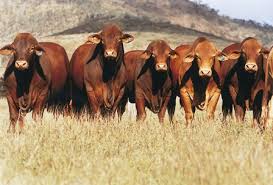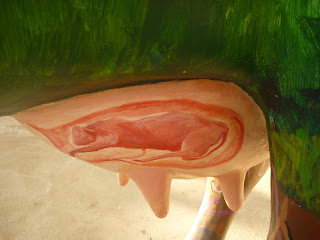Many Australian's don't think about what they're eating when they put the T-bone steak into the oven or they are cooking the beef for a stir fry. So how does the meat get from the farm to you?
These are the main steps in the process that our Young Farming Champion Stephanie Fowler taught us about. There is a lot of hard work, science and innovation involved in each of these steps.
Breeder -------> Finisher -------> Processor ---------> Retailer ----------> YOU
What we have learned is that there are two main ways in which beef is produced in Australia. Cattle are either raised on pasture or in a feedlot. Sometimes a combination of both methods is used.
Feedlots are efficient ways to raise cattle as their diet is contolled to give the best nutrition to the cattle without unecessary waste. However they are expensive to run compared to grazing cattle on pasture.
Australia being the arid continent that it is, with predominately old and infertile soils, does not provide a lot of areas that are suitable for intensive grazing. So in many areas cattle stations are huge properties with low stocking rates. Only in coastal and southern regions of Australia can the soils support richer pasture where farmers can stock cattle at higher rates.
So the breeder is the farmer who makes the choice about which breed or cross-breed of cattle they will raise. British breeds (
Bos taurus) which marble easily are often crossed with tropical breeds (
Bos indicus) which have features that are suited to the Australian climate.
Droughtmasters (
50: 50 B. indicus: B taurus)are a new breed developed in Australia after many years of crossbreeding and meticulous selection for:
- Parasite resistance
- Heat tolerance
- Environmental adaptation
- High fertility
 Calving ease
Calving ease- Docility
- Excellent meat quality
Innovative cattlemen created a breed with the best of both worlds - a breed which could produce and reproduce in the harsh environment as well as resist parasites, whilst economically producing high yielding carcasses of quality beef. Droughtmasters are becoming a highly popular breed for cattle producers in Australia.

Most finishing occurs in some type of feedlot. The diet is scientifically designed to fatten the cattle to produce intra-muscular fat and good quality protein.

When the cattle are the right age and weight they go the processor to be slaughtered. In Australia great care is taken to rest cattle before they are slaughtered not only for their welfare but to ensure that the muscles are rested and that the meat is of the highest quality. We produce enough red meat to feed Australians as well as another 6 million people around the world each year.We also export a large number of live cattle to places like Indonesia. Australia is the world's largest exporter of red meat and livestock, exporting to more than 100 countries.
Our Young Farming Champion Stephanie Fowler is a meat and livestock scientist and from what she showed us there is a lot of research and innovation going into the meat processing phase. New ways of hanging carcases allow the muscles to remain more relaxed and new technologies like the Raman spectroscopy probe that she is using for her PhD research, allow meat graders to make quantitative measurements of meat quality.
In Australia there is a grading system for meat known as Meat Standards Australia.
Meat Standards Australia (MSA) is an independent grading system designed to take the guesswork out of buying and cooking Australian beef. The MSA system was developed by 86,000 consumers who tasted over 603,000 beef samples to identify the key factors that deliver consistent quality beef.
This MSA logo is a visual endorsement of quality for graded cuts of beef indicating that the product has meet quality standards developed by comprehensive consumer research for tenderness, juiciness, and flavour.
MSA does this by taking into consideration the key factors from the farm to plate known to influence beef quality accurately predicting the quality of individual beef cuts and providing a recommended way to prepare these different cuts.

The MSA ‘Graded’ logo. your symbol of quality Australian beef.
Meat and Livestock Australia are an industry body that funds huge amounts of research to produce more red meat with fewer inputs and generate additional value from the global marketplace. Australia's 'clean, green' image and our reputation as a supplier of safe, quality red meat underpin MLA's international marketing activities. They have been working with the UNSW to accurately calculate how much water and energy is used to produce a kilogram of beef.
 media releaseThursday, 28 January 2010
Australian red meat uses less carbon
media releaseThursday, 28 January 2010
Australian red meat uses less carbon
A study undertaken by the University of New South Wales, to be published in the Environmental Science &Technology Journal, has revealed that Australian red meat production is much more efficient than often reported.The three year Life Cycle Assessment (LCA) study across three production systems in Victoria, New South Wales and Western Australia has shown that the carbon emissions from sheep and cattle meat production were amongst the lowest in the world.
Based on figures from the research, eating red meat three times a week results in between 164kg to 258kg of carbon dioxide equivalent emissions a year - vastly different to figures quoted that claim up to 1.5 tonnes.Meat & Livestock Australia's (MLA) Managing Director, David Palmer said that this credible and reliable data gave an accurate reflection of carbon emissions for Australia’s unique production systems.
“Most Australian cattle and sheep are raised in a natural environment feeding on pastures with little or no use of fertilizers and it is unfortunate that until now inaccurate and exaggerated figures have been used”.
“These Australian figures enable us to start having a more meaningful discussion about the industry’s environmental impact”.
The LCA process is a form of cradle-to-grave analysis that attempts to quantify the important environmental impacts of all processes involved in a production system; however it does not take into consideration the ability of soil and trees on farms to absorb carbon. A recent report released by the Queensland Government looked at the total carbon balance on grazing lands in Queensland (47% of Australia’s cattle production) and found they were close to carbon neutral and may in the near future be a net carbon sink.
The United Nations, Food and Agricultural Organisation (FAO) also released a report earlier this month that found grazing lands have the potential to help minimise net greenhouse gas emissions through specific practices, especially those that build soil and biomass carbon.
David Palmer said that the LCA figures were useful to provide a benchmark.
“Importantly the figures give us a baseline from which to continue to improve the industry's performance in regards to emissions, however they do not paint a complete picture and should never be looked at in isolation of other environmental factors such as water and biodiversity".
“Most people are not aware that livestock is the only production industry in Australia to have reduced greenhouse emissions since 1990. According to the Australian Greenhouse office we have reduced our emissions by 7.5%, compared to increases in other industries such as transport and electricity, up 26.9% and 54.1% respectively; we now have a better basis to track improvement in the future”.
“The study shows that when you look across the supply chain from paddock to processing, more than 80% of the carbon emissions come from the natural process of digestion of feed by the animal, which is why MLA has co-invested with the Federal government and other partners in a $28 million program with 18 research projects that are looking at how to reduce emissions from livestock”.
About the Life Cycle Assessment
Life cycle assessment (LCA) is a form of cradle-to-grave or cradle-to-gate systems analysis that attempts to quantify the important environmental impacts of all processes involved in a production system using detailed input data for that system.
The University of NSW LCA showed that sheep meat was estimated to be 7 to 8 kg CO2-e per kg HSCW (unit of product used for red meat) while for beef values ranged from 8 to 11 kg CO2-e per kg HSCW.
Released by: Pip McConachie, MLA Environment Communications Manager, ph. 02 9463 9156.
Finally the meat is graded and sent to the retailer whether they are a butcher, supermarket or distributor. You as the consumer, then buys the meat raw or cooked.
The average Australian eats around 33kg of beef per year (that's 640g per week) and has at least two meals with beef in it per week.











































.jpg)
